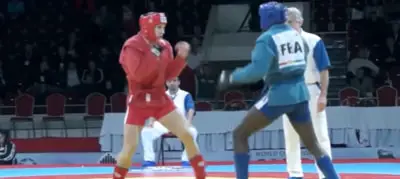
Even though MMA looks way more brutal than boxing, it’s actually safer. In this article, I’m going to give you 11 reasons why is that.
So let’s get started:
1. Fewer Concussions
By far the greatest danger in MMA, boxing, and in combat sports in general, are the concussions. The repetitive blows to the head, make the brain bash against the wall of the skull which causes concussions and brain damage.
There are other different types of injuries in both MMA and boxing, such as broken noses, orbital bones, ribs, hands, and legs as well as shoulder and knee injuries. But they aren’t as near as dangerous as the concussions.
In boxing, there are more concussions than in MMA which makes it the more dangerous sport. I’ll explain why in the rest of the article. Actually the whole article is about concussions in both those sports and also on how to avoid them while training.
2. Grappling and Wrestling
The less time people spend in trading blows the lesser the chance of causing each other brain damage is. Unlike boxers, MMA fighters also wrestle and grapple as well as use striking techniques.
Other than slams, there aren’t many ways to concuss somebody while grappling or wrestling. There are other injuries fighters can get while working on the BJJ skills, or on their wrestling (mostly joint injuries – knee, hip injuries, etc) but brain injury isn’t one of them.
3. Fight Finishing in MMA vs Boxing
One of the biggest reasons why boxers get brain damage during fights is the knockdown rules. After a knockdown, the boxer has 10 seconds to get up and continue fighting.
Some knockdowns are caused by a quick punch that the boxers don’t see and they are quickly able to recover and get back up. But often boxers are really hurt even though they can stand on their feet. Once they do that, the punishment continues which isn’t great for the already concussed brain.
A boxer can get knocked down several times in a single round!
The time boxing rules give fighters to recover after a knockdown is good from a certain point of view because that gives them a chance to win. But they also hurt boxers in many cases.
While in MMA, there are no such knockdown rules. If a fighter gets dropped, usually his opponent follows him to the ground and tries to finish the fight via ground and pound or submission.
There’s no 10-second count in MMA, which may look more brutal but it’s actually an easier way out for fighters. Later I’ll explain why ground and pound strikes still hurt but are not as dangerous as strikes on the feet.
Some boxers and MMA fighters are too tough for their own good, as some commentators like to say, so they’ll get up if they have the opportunity even though they know they are hurt badly.
4. MMA Bouts are Shorter
This one is obvious but it’s still worth mentioning. Boxing bouts are 10-12 rounds, 3 minutes each. That makes 30-36 minute fighting.
Modern MMA bouts are 3-5, 5-minute rounds where only title fights and main events are 5 rounds. After some simple math, we see that MMA fights can be up to 15 minutes shorter than boxing matches.
The fewer time fighters spend fighting the less damage they take.
5. Clinching and Dirty Boxing
The stricter the clinching rules are, the more knockouts we see in fights. For example in K1 kickboxing, fighters weren’t allowed to use clinching to stall the fights. They could clinch but they were allowed to throw just one knee, after which the referee separates them.
That is one of the reasons why there were so many knockouts in K1 and why it was so popular.
Boxing rules are very similar. You can’t grab your opponent and punch him or use clinching to stall the fight. Although boxers do it, the referees try to separate them as quickly as possible.
In MMA, there is clinching and cage wrestling where fighters use dirty boxing and knees to the body to do damage. But in the clinch, those techniques don’t as nearly the same impact because you can’t get the same leverage as when you are in your stance.
6. MMA Fights are Easier to Stall
When you get stunned or rocked in boxing you don’t have other options other than to clinch. But the referee will quickly separate you from your opponent and you are again in danger.
In MMA other than clinching you can also go for the legs of your opponent, take him down and use the time when he’s on his back to recover.
But also unlike in boxing, in MMA, as I already mentioned in the reason number 5, clinch fighting is allowed, so you can stay in the clinch and recover as long as you aren’t completely inactive.
That’s why finishing your opponent in MMA is much trickier than in boxing. In boxing, the only danger when trying to finish hurt opponents is the counter punches, while in MMA, the other fighter can also try to take you down or just clinch and stall the fight.
That stalling gives fighters more time to recover and makes MMA a little safer especially for hurt opponents.
7. MMA Sparring vs Boxing Sparring
Most of the long term brain damage is caused due to gym wars/hard sparring, not the actual fights. That’s because fighters spar several times a week while most of them fight no more than 3 times a year.
Concussions and even knockouts after hard sparring sessions happen regularly. Old school gyms encourage regular hard sparring and brawls because their thinking is that the more punishment you take, the tougher you get and the more you can endure.
And that is true to a certain extend, everyone who wants to compete should do hard sparing at some point. But regular hard sparring is super harmful to the fighters. Those hard blows to the head on a regular basis build CTE in the long run.
Nowadays fighters and trainers are much more aware of that due to the medical researches on CTE among athletes in different sports. Fighters spar hard only when preparing for a fight, and the rest of the time they focus on more technical sparring and drills.
The difference between boxing and MMA sparring, though is that boxing sparring is basically just boxers punching each other in the head and body, while MMA fighters also often take each other down and grapple which makes MMA sparring less concussive.
8. Kicks
Although high kicks can certainly be concussive, a big percentage of the kicks in MMA are thrown to the legs and the body of the opponent.
That’s the same reason why Muay Thai is less dangerous than boxing in terms of brain damage – fighters attack each other’s bodies more than attacking the head.
Also, fighters keep a longer distance than in boxing because of the kicks and it’s harder to land punches to the head.
But don’t get me wrong, a high kick knockouts are much more vicious than knockouts caused by punches. The thing is that they are much harder to land than punches and occur less often because of that.
9. Ground and Pound
As brutal it may look, the ground-and-pound is actually less concussive than punches to the head in a stand-up (like all the punches in boxing).
When you are in your fighting stance you have much more leverage in your punches because you can use your legs and put your whole body weight into the shot, while on the ground you are pretty much-throwing arm punches, which are much weaker.
Most of the knockouts because of ground and pound are on already hurt the opponent or they are just TKO – when the referee stops the fight because the fighter who is on the ground doesn’t fight back or defend himself intelligently.
Real knockouts due to ground and pound are super rare and most of the time they’re caused by elbows, like in the Yoel Romero vs Lyoto Machida fight or the Darren Till vs Wendell de Oliveira fight.
10. Shorter Amateur Careers
The less your fight the less damage you take.
It’s not uncommon for boxers to have 50+ amateur bouts before becoming pro and 30-40 or even more fights as professionals. Although amateur fights are just 3 rounds, they are still fights and boxers take some damage when competing as amateurs.
Boxing is an Olympic sport and a lot of boxers compete in the Olympics or national championships before becoming professionals.
On the other hand, MMA fighters usually compete in no more than 5 amateur bouts. Amateur MMA fighters, you don’t earn any money or achievements so they compete as amateurs just to get some experience before turning pro and avoid losses on their pro record.
Money is the most common reason why most of the fighters are so impatient to finish with their amateur fights and turn pro.
11. Historical Data
Western boxing, the one we watch today, is more than 100 years old. Boxing rules are much more limited compared to MMA, and pretty much everything in boxing is already discovered in terms of technique and training methods.
But it wasn’t like that back in the day. The sport needed innovator boxers such as Muhammad Ali, and brilliant trainers like Cus D’amato to become what it is today. Now boxers know how to fight and train the most effective and most safe way possible.
Unlike boxing, MMA is still a new sport. In started in the 1990s but MMA fighters use boxers, wrestlers, BJJ fighters and other combat sports athletes from more established sports as examples on how to train more safely.
MMA didn’t start from scratch, it has all those other sports as models and that’s why fighters know how to train more safely, although it’s still an evolving sport.
Drawbacks of MMA in Terms of Safety
MMA is the closest sport to an actual fight, so it’s obviously not the safest sport. Although less often than in boxing, concussions happen in MMA due to punches, kicks, elbows, and knees to the head but also slams.
Knees and elbows
A knee to the head is probably the most powerful strike a human can throw and can definitely concuss somebody. There are many knockouts caused by a knee to the head. Examples for that are the Jorge Masvidal vs Ben Askren or the Yoel Romero vs Chris Wideman fights.
Elbows are also super powerful because of the leverage. Most dangerous elbows are the rear hand elbow to the head and the spinning back elbow.
Slams
To throw somebody on his head, or to fall on your head when taking somebody down definitely sucks and can concuss you.
Slams/falling on your head are supper dangerous and they are the reason why wrestling is one of the sport with most concussions.
In MMA such things occur much less often than in wrestling but they still happen. If you want to see a brutal slam KO in MMA, I suggest watching the Jessica Andrade vs Rose Namajunas fight.
Grappling Injuries
When practicing BJJ or wrestling you’re almost guaranteed to have an even minor injury at some point no matter how safely you train.
The most common injuries in grappling are knee, neck, and some small joint (finger, toes) injuries.
Kickboxing Injuries
Kicking somebody is dangerous not only for the person your but also for you. If your opponent blocks your kick with his elbow, that can break your foot and prevent you from training for more than a month.
Other than that, you can get pretty nasty bruised ribs due to kicks which can make you feel this pain in your ribcage for a long time.
Smaller Gloves
MMA gloves are more dangerous than boxing gloves because they have much less padding. Competitive boxing gloves are 8 – 10 oz fore boxing vs 4 oz MMA gloves. Punches certainly feel differently the smaller the gloves are.
I was never hit super hard to the ribs with an MMA glove so I’m not sure how that feels, but if you get punched hard in the ribs bare-knuckle, you can get bruised ribs for more than a month. I assume that with MMA gloves is something similar.
Diversity of Attacks
Kicks, knees, elbows, and takedowns are not just dangerous on their own, but also as setups for a different attack.
For example, an MMA fighter can fake a takedown and throw an overhand. The opponent drops his hands to stuff the potential takedown and gets caught with a clean shot to the head.
Such feint/fakes lower the striking defense even of the best strikers. That way Khabib Nurmagomedov was able to knock Conor Mcgregor down who is a much better boxer/striker.
Since there are so many different techniques in MMA, the combinations of different setups are countless. A fighter can fake a punch to make his opponent slip and intercept his head movement with a high kick, catch his opponent with an uppercut, knee or elbow of a fake takedown attempt, and many others.
or That makes the variables in MMA much more than in boxing and it’s harder to defend so many different techniques. That’s why we don’t see head movement in MMA or kickboxing like in boxing. Every wrong slip or duck is a potential kick, knee, elbow, or punch to the face.
Conclusion
Although there are fewer rules in MMA than in boxing and much more possible attacks, I still believe than MMA is the safer sport because of the fewer blows to the head that fighters absorb which means fewer concussions.



